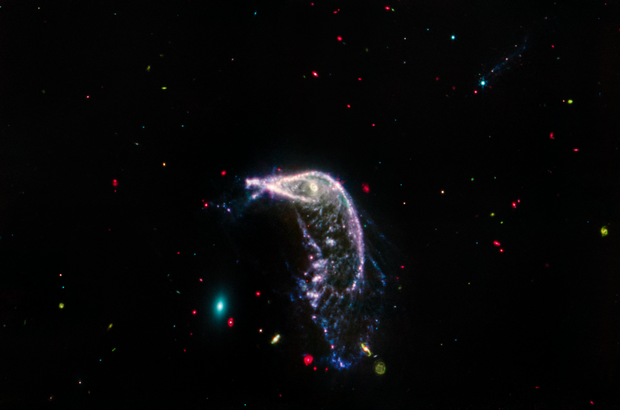
NASA's James Webb Space Telescope Celebrates Second Anniversary with Stunning Images of Entwined Galaxies, Known as 'Penguin' and 'Egg'
On the occasion of its second anniversary, NASA released new images from the James Webb Space Telescope (JWST) showing a pair of entangled galaxies named Arp 142 or Penguin and Egg. These galaxies are located approximately 326 million light-years away from Earth in the constellation Hydra.
The two galaxies, which have been interacting for tens of millions of years, are collectively known as 'the Penguin and the Egg.' The Penguin galaxy is a distorted spiral that resembles a penguin in the middle due to its gravitational interaction with the Egg galaxy. The Egg galaxy, on the other hand, remains relatively unchanged.
The JWST's Near-Infrared Camera and Mid-Infrared Instrument have revealed details about these galaxies, showing a blue haze representing stars and gas that connects them. Star formation has occurred in parts of the Penguin galaxy due to gravitational tugs from the Egg galaxy.
The JWST's sensitivity allows it to identify crucial molecules for life like water vapor, methane, and carbon dioxide in the atmospheres of potentially habitable planets. It currently knows of around 30 planets that may be 'small, rocky planets like Earth and that orbit in the habitable zone.'
The two galaxies first interacted between 25 and 75 million years ago and will merge into a single galaxy hundreds of millions of years from now. The JWST's ability to see inside big dust clouds makes it possible for scientists to study stars as they form, allowing them to watch these stars evolve and study how planetary systems are born around them.
The James Webb Space Telescope is a collaborative effort between NASA, the European Space Agency (ESA), and the Canadian Space Agency (CSA). Unlike its predecessor, the Hubble Space Telescope, which orbits around Earth, the JWST orbits the sun at a distance that keeps it cooler than other spacecraft. This allows it to operate more efficiently in infrared light.




